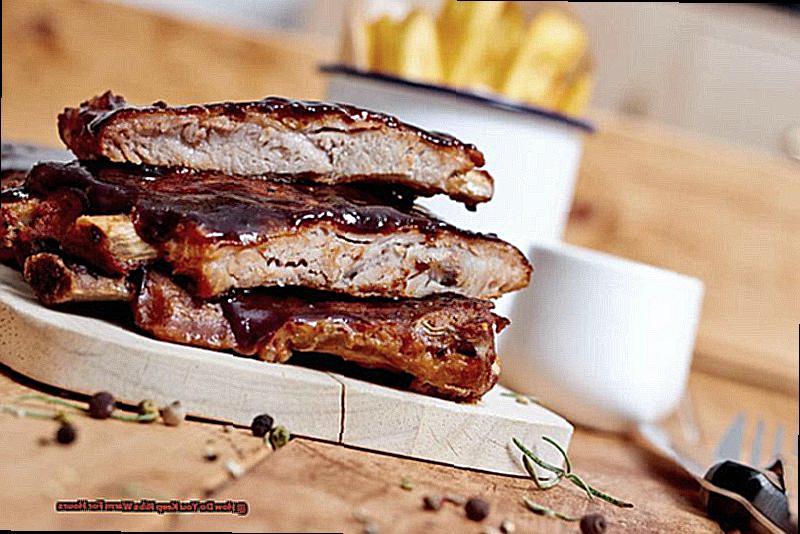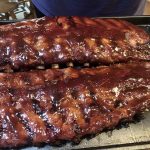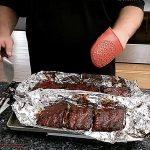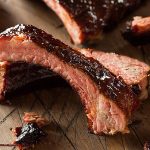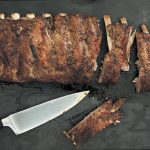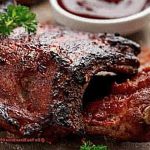Imagine this: the aroma of slow-cooked ribs wafting through your kitchen, teasing your taste buds with promises of tender and flavorful meat. You eagerly take them out of the oven, only to realize that your guests won’t be arriving for a few more hours. How do you keep these mouth-watering ribs warm without losing their juiciness and flavor?
With our simple tips, you can ensure that your ribs stay warm and delicious for hours on end. Here’s how:
- First, tightly wrap the ribs in aluminum foil to trap heat and moisture.
- Next, place the wrapped ribs in an insulated cooler or set them in an oven on low heat.
- For extra insulation, add a layer of towels or blankets on top.
- Use a meat thermometer to monitor the internal temperature and make sure it stays above 140°F.
- Keep the cooler or oven closed until it’s time to serve.
- If needed, you can also use a warming tray or slow cooker for a lower heat option.
By following these steps, you can rest easy knowing that your ribs will stay warm and succulent for hours while you entertain your guests. Say goodbye to reheating food and hello to perfectly warm ribs every time.
Contents
- 1 How to keep ribs warm
- 2 What is the most effective method for keeping the ribs warm?
- 3 What works best?
- 4 How to reheat ribs in an oven
- 5 The best way to reheat ribs:
- 6 Can I reheat ribs a second time if I have leftovers?
- 7 How soon should I freeze/refrigerate my ribs?
- 8 How long can I store cooked ribs?
- 9 How do I know if my stored meat is bad?
- 10 How to store cooked ribs in the best ways
- 11 What works best?
- 12 How to reheat ribs in an oven
- 13 The best way to reheat ribs:
- 14 Can I reheat ribs a second time if I have leftovers?
- 15 How soon should I freeze/refrigerate my ribs?
- 16 How long can I store cooked ribs?
- 17 How do I know if my stored meat is bad?
- 18 How to store cooked ribs in the best ways
- 19 Conclusion
How to keep ribs warm
One of the biggest challenges when preparing for a BBQ is keeping ribs warm for several hours. However, with the right techniques, you can guarantee that your ribs will remain warm, succulent, and full of flavor. Here are some effective ways to keep ribs warm for several hours:
Wrap them in foil and reheat on the grill
This method involves wrapping the ribs in foil and placing them on a preheated grill for reheating. The grill will help retain heat and moisture in the ribs, ensuring they stay warm and tender.
Reheat them in a slow cooker
Slow cookers are perfect for keeping food warm for long periods of time. Simply place the ribs in the slow cooker and set it to low heat. The ribs will remain warm and tender until it’s time to serve.
Place them on a heat-proof plate
Another easy method is to place the ribs on a heat-proof plate, cover with foil, and put it in a low-temperature oven until it’s time to serve.
Use a food warmer
Food warmers are specifically designed to keep food warm for extended periods of time. They come in various sizes and can be purchased at most kitchen supply stores.
Wrap them in a cooler
For outdoor BBQs, you can wrap your ribs in a cooler with foil, paper, freezer paper, or towels to retain heat and moisture. This technique is particularly useful when transporting the ribs from one location to another.
Keep them in a low oven
If you have access to an oven during your BBQ, you can keep the ribs warm by placing them in a low-temperature oven until it’s time to serve. Just make sure to monitor the temperature closely to avoid overcooking.
In conclusion, there are multiple methods available to keep ribs warm for several hours while preparing for a BBQ.
What is the most effective method for keeping the ribs warm?
Ribs are a must-have at any BBQ, but keeping them warm and tasty for long periods can be a daunting task. Thankfully, there are numerous effective methods that you can use to ensure your ribs remain warm and maintain their succulent flavor.
- Utilize a food warmer: A food warmer is an excellent option for keeping your ribs warm for hours. Simply place the cooked ribs in the warmer, set the temperature to low or warm, and cover with foil to lock in heat and moisture.
- Wrap in foil with liquid: Another alternative is to wrap your ribs in foil with a small amount of liquid (such as apple juice or beer) and place them in a preheated oven or on a heated grill. This method helps retain moisture and heat, ensuring your ribs stay warm and tender.
- Finish on the grill or stovetop: If you have access to a grill or stovetop at your BBQ, you can finish cooking or reheat your ribs by placing them on a preheated grill or pan. This technique adds a delightful char and smoky flavor to your ribs while also keeping them warm.
- Use a slow cooker: Slow cookers are another fantastic option for keeping ribs warm for extended periods. Simply place the cooked ribs in the slow cooker on the low or warm setting and cover with foil. This method helps seal in moisture and keep the ribs tender.
- Wrap in towels and place in cooler: For outdoor BBQs, wrapping your cooked ribs in towels and placing them in a cooler can keep them warm for several hours. Just make sure to preheat the cooler with hot water beforehand.
Remember, when reheating leftover ribs, it is best to wrap them in foil with some added sauce before heating in the oven at 250-325°F for 20-30 minutes. Leftover ribs should also be stored promptly in the fridge and consumed within 3-4 days for optimal safety and taste.
There are numerous effective methods for keeping ribs warm for extended periods. Whether you have a food warmer, grill, slow cooker, or cooler at your disposal, these techniques will help you serve up delicious and tender ribs at your next BBQ.
What works best?
When it comes to maintaining warm and succulent ribs for hours at a BBQ, there are many different methods that work best. These techniques include using a food warmer, wrapping the ribs in foil with liquid, finishing on the grill or stovetop, utilizing a slow cooker, or wrapping in towels and placing in a cooler. Not only do these methods keep your ribs warm, but they also help preserve their juicy texture and flavorful taste.
Food Warmer:
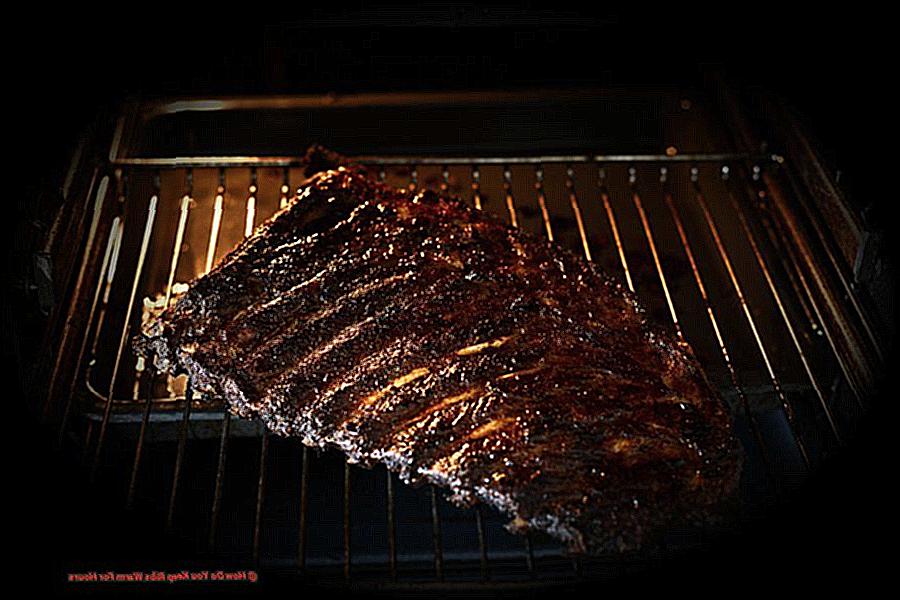
One highly effective approach is to use a food warmer. Simply place the ribs in an oven-safe dish, cover with foil, preheat the oven to 200 degrees Fahrenheit, and heat for 30 minutes or until warmed through. This method is particularly useful for larger quantities of ribs and will prevent them from drying out while keeping them warm.
Foil Wrapping with Liquid:
Another great technique is to wrap the ribs in foil with a liquid such as apple juice or beer. The steam created from the liquid will keep the ribs moist and tender while also retaining their succulent flavors. Reheat in a 300-degree oven for 20-30 minutes or until warmed through.
Finish on Grill or Stovetop:
For those seeking a smokier taste, finishing cooking the ribs on the grill or stovetop before serving is an excellent option. Simply wrap the ribs in foil and place on a preheated grill or stovetop for 5-10 minutes prior to serving. This method allows you to keep your ribs warm while still achieving that desirable charred and smoky flavor.
Slow Cooker:
A slow cooker is another fantastic choice for maintaining warm and juicy ribs. Place the ribs in the slow cooker on low heat and let them warm up for 1-2 hours before serving. This method is perfect for keeping your ribs warm for an extended period while also preserving their tenderness and moisture.
Towel Wrapping and Cooler:
For a more low-tech approach, wrapping the ribs in towels and placing them in a cooler is an excellent option. This method is ideal for outdoor BBQs and ensures your ribs stay warm and ready to eat for hours.
In conclusion, these are the most effective methods for keeping ribs warm for hours at a BBQ. Choose the technique that best suits your needs and equipment, and enjoy delectable and succulent ribs at your next BBQ. Remember to promptly store leftovers and consume within 3-4 days for optimal safety and flavor.
How to reheat ribs in an oven
To achieve perfectly reheated ribs, it is best to follow the “low and slow” method with an oven temperature of 250 degrees Fahrenheit. This ensures that the ribs are heated evenly without drying out or becoming tough. The time required for reheating depends on the type of ribs and personal preferences. Generally, spare ribs and St. Louis style ribs take 20-30 minutes, while baby back ribs take 45 minutes. To avoid drying out, it is crucial to take the ribs out of the fridge 30 minutes before reheating.
For a delicious and caramelized glaze, try removing the foil during the last 5 minutes of reheating and placing the ribs under the broiler. This will give them a crispy exterior while keeping them juicy on the inside. However, if you are reheating dry-rub ribs, skip this step and add some water or drippings before wrapping in foil to prevent them from becoming too dry.
For safety, always use a meat thermometer to ensure an internal temperature of at least 165 degrees Fahrenheit before serving. This is especially important when reheating leftovers as bacteria can grow if they are not heated to a safe temperature.
There are various methods for reheating ribs in the oven, including using a smoker, toaster oven, slow cooker, grill, or sous vide technique. Each method may vary in terms of time and temperature, so it is essential to follow specific instructions for each device.
In conclusion, reheating ribs in an oven at 250 degrees Fahrenheit for 20-30 minutes is the best method to achieve delicious and tender results. Remember to take the ribs out of the fridge 30 minutes before reheating, use a meat thermometer for safety, and adjust cooking times based on personal preferences and the type of ribs being reheated.
The best way to reheat ribs:
For the most succulent and flavorful ribs, reheating them in the oven at a low temperature of 250 degrees Fahrenheit for 20-30 minutes is the ideal method. This ensures that the ribs retain their moisture and tenderness, giving them a fresh-off-the-grill taste. However, there are several other effective methods to reheat ribs, including using a smoker, toaster oven, slow cooker, grill, or sous vide.
| Method | Temperature | Cooking Time |
| Oven | 250 degrees Fahrenheit | 20-30 minutes |
| Smoker | 225-250 degrees Fahrenheit | 1 hour |
| Toaster Oven | 350 degrees Fahrenheit | 15-20 minutes |
| Slow Cooker | Low setting (200-250 degrees Fahrenheit) | 2-3 hours |
| Grill | Medium heat (350-375 degrees Fahrenheit) | 10-15 minutes per side |
| Sous Vide | 145-165 degrees Fahrenheit (based on personal preference) | 2-3 hours |
No matter which method you choose, it is crucial to properly wrap the ribs in foil before reheating. This prevents them from drying out and allows the juices to redistribute evenly, resulting in mouth-watering ribs. Additionally, letting the ribs rest for a few minutes before serving will further enhance their tenderness.
While reheating ribs in the oven at 250 degrees Fahrenheit for 20-30 minutes is the top choice, there are also other effective methods with varying times and temperatures. It is essential to wrap and rest the ribs properly in all methods to ensure they remain juicy and delicious.
Can I reheat ribs a second time if I have leftovers?
The answer is yes, but it’s crucial to follow proper storage and reheating methods to ensure the ribs are still safe to eat and maintain their delicious flavor and texture.
First and foremost, it’s important to properly store leftover ribs. This means refrigerating them as soon as possible after cooking. To prevent moisture loss, you can wrap them in foil, baking paper, or place them in a zip lock bag or vacuum-sealed bag. It’s also recommended to cut the ribs into single-serving sized portions for easier reheating.
When it comes to reheating, there are several methods you can use. One popular option is using a microwave. Simply transfer the ribs into a microwave-safe dish, sprinkle with apple juice, water, or stock, and add some sauce if desired. Cover the dish with a damp paper towel or plastic wrap and heat on 0% power for 60 seconds, then continue heating in 0-second intervals until hot enough to serve.
Another effective method is reheating in the oven at 250 degrees Fahrenheit for 20-30 minutes. This helps retain moisture and tenderness in the ribs. Other options include using a smoker, toaster oven, slow cooker, grill, or sous vide.
Regardless of which method you choose, it’s important to properly wrap and rest the ribs before reheating to ensure juicy and delicious results.
How soon should I freeze/refrigerate my ribs?
It is highly recommended to freeze or refrigerate ribs as soon as possible before a BBQ event. Properly storing and preparing ribs is essential for maintaining their freshness and ensuring safety for consumption.
Here are some tips for freezing and refrigerating ribs before a BBQ event:
- Refrigeration: If you plan on cooking your ribs within the next few days, it is safe to refrigerate them. Ensure that the ribs are stored in an airtight container or tightly wrapped with plastic wrap. To avoid cross-contamination, it is best to keep them on the bottom shelf of the fridge.
- Freezing: For long-term storage, it is advised to freeze raw ribs rather than cooked ones. Wrap the ribs tightly with plastic wrap and then place them in an airtight container or freezer bag.
- Thawing: When it’s time to thaw your ribs, it is crucial to do so safely. The best method is to thaw them in the refrigerator overnight. This guarantees that they will defrost evenly and at a safe temperature.
| Method | Time | Instructions |
| Refrigeration | Within a few days | Store ribs in an airtight container or wrap tightly with plastic wrap, and keep on the bottom shelf of the fridge. |
| Freezing | Long term storage | Tightly wrap raw ribs with plastic wrap and place in an airtight container or freezer bag. |
| Thawing | Overnight in refrigerator | To ensure safe and even defrosting, thaw ribs in the refrigerator overnight. |
By following these guidelines, you can guarantee that your ribs will remain fresh and safe to consume throughout your BBQ event. Properly storing and preparing your ribs is crucial for maintaining their quality and ensuring their safety.
How long can I store cooked ribs?
This does not provide a guarantee of safety for the ribs as some bacteria may still be present. To ensure the safety and freshness of your cooked ribs, it is crucial to follow proper storage guidelines.
Proper Storage Guidelines:
Refrigerate within 2 hours: To reduce the risk of food-borne illness, it is recommended to refrigerate cooked ribs within 2 hours of cooking.
Store on the lowest shelf towards the back of the fridge: This will prevent any juices from the ribs from dripping onto other foods, which could potentially lead to contamination.
- Consume within 3 to 4 days: For optimal safety and taste, leftovers should be consumed within 3 to 4 days. If not, they should be frozen for long-term storage.
- Freeze for up to 3 months: If you are planning to consume your leftovers after 3 to 4 days, it is safe to freeze them for up to 3 months.
- Reheat properly: When reheating cooked ribs, it is important to ensure that they reach an internal temperature of at least 165 degrees Fahrenheit to eliminate any remaining bacteria.
Alternative Reheating Methods:
- Oven: Preheat your oven to 250 degrees Fahrenheit and place your ribs in a baking dish with a small amount of liquid (such as broth or apple juice). Cover with foil and bake for about 20 minutes until heated through.
- Slow Cooker: Place your ribs in a slow cooker with a small amount of liquid and cook on low for 1-2 hours until heated through.
- Sous Vide Technique: This method involves placing your vacuum-sealed ribs in a water bath and cooking them at a precise temperature for a set amount of time.
- Enjoy Cold: If you prefer to enjoy your ribs cold, add some flavor enhancements such as warm barbecue sauce or a squeeze of fresh lemon juice to add extra tasty and safe flavors.
To conclude, cooked ribs should be stored safely in the refrigerator within 2 hours, and leftovers should be consumed within 3 to 4 days or frozen for long-term storage. By following proper storage guidelines and reheating methods, you can ensure the safety and freshness of your delicious ribs for your next BBQ event.
How do I know if my stored meat is bad?
When it comes to meat, it is important to have a good understanding of when it may have spoiled in order to prevent any foodborne illnesses. Here are some key indicators to look out for when examining your stored meat for signs of spoilage.
- Check the expiration date: Always make sure to take a look at the best by date on your meat packaging. This date marks the last day that the meat is considered to be at its peak quality and should be consumed by. If the date has passed, it is best to dispose of the meat.
- Check its appearance: Take a close look at the meat for any changes in color or texture. A grey or slimy appearance is a sure sign that it has gone bad.
- Check its texture: When handling the meat, it should feel firm and dry. If it feels damp, moldy, or sticky, this could indicate spoilage.
- Check its smell: One of the most obvious signs of spoiled meat is a foul odor. If your cooked meat emits a rancid or ammonia-like smell, it is best to get rid of it right away.
- Check its storage time: It is important to keep track of how long your cooked meat has been sitting in the fridge. Typically, cooked meat can be safely stored in the refrigerator for 3-4 days. After that, either consume it or freeze it for longer storage.
If you come across any of these signs when checking your stored meat, it is best to err on the side of caution and discard it. Consuming spoiled meat can lead to food poisoning and other health issues. When in doubt, always trust your senses and prioritize food safety.
| Spoilage Indicators for Meat | What to Look For | Action Required |
| Expired best by date | Refer to the expiration date on the packaging | Dispose of the meat if the date has passed |
| Unusual color or texture | Closely inspect the meat visually | Discard it if it appears grey or slimy |
| Damp, moldy, or sticky texture | Use clean hands to touch the meat | Dispose of it if it feels damp, moldy, or sticky |
| Foul odor | Smell the meat before cooking or consuming | Get rid of it immediately if it has a rancid or ammonia-like smell |
| Stored in fridge for too long | Keep track of how long the meat has been in the fridge |
How to store cooked ribs in the best ways
How to store cooked ribs in the best ways for several hours without losing heat and moisture is crucial for keeping them warm and delicious. Here are some effective methods you can use:
Use an Insulated Container or Cooler
- The most effective way to keep ribs warm for several hours is to use a restaurant-quality insulated container or cooler.
- If you don’t have a commercial insulated container, you can create your own by lining a cooler with towels.
- Place the ribs inside and cover them with more towels to retain heat.
Wrap in Foil and Place in a Low Oven
- Another method to keep ribs warm is by wrapping them in foil and putting them in a low oven (200°F) for approximately an hour.
- Before wrapping, coat the ribs with a mixture of BBQ sauce and apple cider vinegar to keep them moist.
Vacuum Seal or Store in a Foil Pan or Freezer Zip Top Bag
To retain heat and moisture, vacuum seal the ribs in a plastic bag or store them in a foil pan or freezer zip top bag.
- This method is especially useful when transporting ribs to a BBQ party or event.
Keep in Slow Cooker, Heat-Proof Plate, Preheated Grill, or Stovetop/Oven
- Other options for keeping ribs warm include leaving them in a slow cooker, on a heat-proof plate, on a preheated grill, or on the stovetop or oven at low heat.
- Remember to regularly check the temperature and adjust accordingly to prevent overcooking.
By using these methods, you can ensure that your cooked ribs remain warm, fresh, and delicious when served. For optimal freshness, consume ribs within 16 hours of cooking.
What works best?
There are several techniques you can utilize to maintain the warmth, tenderness, and flavor of your ribs for an extended period of time without sacrificing their quality.
Faux Cambro Method:
This approach entails using a heated cooler to create a well-insulated environment for the cooked ribs. Simply wrap the ribs securely in aluminum foil and place them in the preheated cooler, filling any gaps with towels or newspapers to retain heat and moisture.
This technique is frequently employed by competitive BBQ teams and is highly effective in maintaining the warmth of ribs for up to 4 hours.
Food Warmer:
Investing in a food warmer is another excellent option for keeping your ribs warm for an extended period of time. These appliances are specially designed to preserve the temperature and tenderness of food for 2-6 hours, making them ideal for BBQ parties or events.
Efficient Planning:
One of the crucial factors in maintaining the warmth of ribs is to plan your cooking and serving times effectively. It is recommended to finish cooking the ribs no more than 4 hours before serving to avoid having to store them for too long.
Butcher Paper or Oven Wrap:
For shorter periods of time, you can wrap the cooked ribs in butcher paper or foil and store them in an oven set at a low temperature (around 170°F). However, be careful not to overcook or dry out the ribs in this process.
Prevent Evaporation:
Wrapping the ribs in foil or periodically spritzing them with vinegar or other juices can help prevent evaporation and ensure that the meat stays moist and tender.
Reheating Leftovers:
If you have leftovers, it is crucial to reheat them properly to avoid drying out the ribs. You can do this by placing them in an oven or slow cooker at low temperatures, avoiding direct heat contact.
Adjust Cooking Times:
Different types of ribs may require different cooking times, so it is important to adjust accordingly and plan efficiently to serve freshly cooked ribs whenever possible. For instance, spare ribs usually take longer to cook than baby back ribs.
These are some effective methods for maintaining the warmth of ribs for an extended period of time.
How to reheat ribs in an oven
Maintaining the warmth of ribs for an extended period requires reheating them at a low temperature. The ideal temperature for reheating ribs in an oven is between 200°F to 250°F. This low temperature ensures that the ribs do not dry out or become tough while keeping them warm for hours.
To achieve this, follow these simple steps:
- Preheat the oven to 200°F to 250°F.
- Take the ribs out of the refrigerator at least 30 minutes before reheating. Bringing them to room temperature helps in even reheating.
- Wrap the ribs tightly in foil and place them on a baking sheet or an oven-safe pan.
- Reheat the ribs in the oven at the desired temperature for 10-15 minutes.
- For safety reasons, check the doneness of the ribs by inserting a meat thermometer into the center of the meat. The internal temperature should reach 165°F (74°C).
- Once heated through, remove the ribs from the oven and serve immediately. If you are not ready to serve, you can turn off the oven and keep them inside to maintain their warmth for a longer duration.
- Alternatively, if you have a food warmer or portable warmer, you can use it instead of an oven to keep your ribs warm for hours.
Here is a table summarizing the recommended temperature and time for reheating ribs in an oven:
| Temperature | Time |
| 200°F | 15-20 minutes |
| 250°F | 10-15 minutes |
Remember, it is crucial to monitor the internal temperature of the ribs to ensure they are thoroughly heated without overcooking.
The best way to reheat ribs:
The best way to reheat ribs to keep them warm for hours is by using the oven. This method is preferred because it keeps the ribs moist and flavorful, and requires minimal attention during the reheating process.
However, alternative methods such as using a smoker, toaster oven, slow cooker, or grill can also be effective. Sous vide is another option that results in ultra moist and tasty ribs, but it requires more time and equipment.
It is essential to properly store and reheat the ribs to keep them warm for hours. Here are some tips to ensure your ribs stay warm and delicious for an extended period:
Proper Storage:
- After indulging in your BBQ feast, store any leftover ribs in an airtight container or tightly wrap them in foil.
- Place them in the refrigerator within two hours of cooking to prevent bacterial growth.
- It is not recommended to leave ribs at room temperature for more than two hours.
Reheating in the Oven:
- Preheat your oven to 200°F to 250°F.
- Bring the ribs to room temperature before reheating.
- Wrap the ribs tightly in foil to prevent them from drying out.
- Place them on a baking tray and reheat for 10-15 minutes, checking their internal temperature with a meat thermometer.
- When the internal temperature reaches 165°F, the ribs are ready to be served.
Other Methods:
- Using a smoker: Follow the same steps as reheating in the oven, but place the ribs in a smoker instead.
- Toaster oven: Follow the same steps as reheating in the oven, but use a toaster oven instead.
- Slow cooker: Place the ribs in a slow cooker and add a small amount of liquid (such as broth or BBQ sauce) to keep them moist. Cook on low for 4-6 hours.
- Grill: Preheat your grill to medium heat and place the ribs on the grill. Flip them occasionally and brush with BBQ sauce to keep them moist. Cook for 10-15 minutes or until heated through.
Sous Vide:
- Preheat your sous vide cooker to 165°F.
- Place the ribs in a vacuum-sealed bag and submerge them in the water bath for two hours.
- Once done, remove the ribs from the bag and pat them dry before finishing on the grill or in the oven for a few minutes for added flavor.
In conclusion, reheating ribs in the oven at a low temperature is the best method to ensure they stay warm for hours. However, other methods can also be effective with proper attention and monitoring.
Can I reheat ribs a second time if I have leftovers?
Absolutely. As long as they are stored correctly and reheated to the appropriate temperature. According to the USDA (United States Department of Agriculture), cooked meat should be refrigerated within two hours of cooking and consumed or reheated within four days. If your ribs are stored in an airtight container in the fridge set below 40°F, they can be safely reheated multiple times. Just make sure that the internal temperature of the ribs reaches 145°F to eliminate any potential bacteria.
To maintain the mouth-watering flavor and tenderness of your reheated ribs, it is recommended to use either an oven or smoker at a low temperature. These methods allow for better control over the temperature and help retain moisture, resulting in juicy and delicious ribs. While reheating ribs on a grill is also an option, it may not provide the same level of flavor as a smoker. Other methods such as using an air fryer, sous vide machine, or microwave can also be used, but if not done correctly, they may result in dry or overcooked ribs.
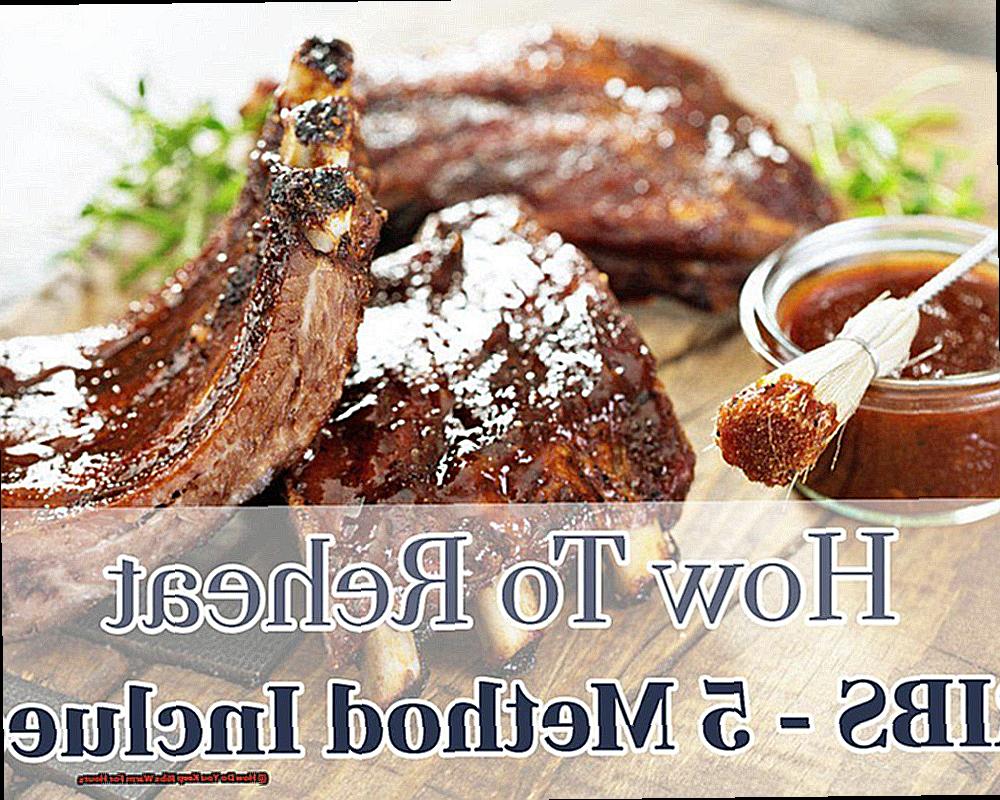
It is crucial to pay attention to any signs that your ribs have gone bad, such as significant changes in appearance, unpleasant smells, or changes in texture. If you notice any of these indicators, it is best to discard the ribs to avoid foodborne illnesses. Properly storing and reheating your leftover ribs can help prevent them from spoiling and ensure that you can savor them for multiple meals.
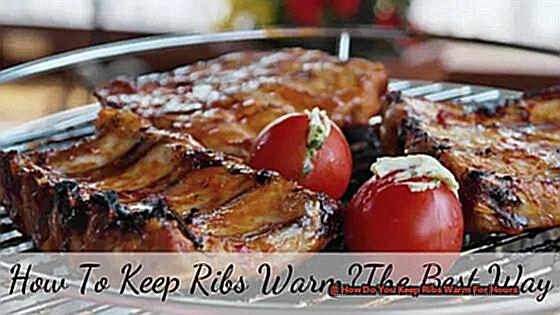
How soon should I freeze/refrigerate my ribs?
To ensure the freshness of your ribs for extended periods, it is crucial to refrigerate or freeze them promptly after cooking or buying. The general guideline is to refrigerate cooked ribs within two hours of being at room temperature and freeze them within 2-3 days. However, this timeframe may vary depending on factors such as the temperature of your refrigerator, the type of ribs, and their storage method. Let’s take a closer look at when it is best to transfer your ribs to the fridge or freezer for optimal freshness.
| Raw Ribs | Cooked Ribs |
| It is recommended to store them in their original packaging for up to 3-5 days in the refrigerator. | Store them in shallow, airtight containers or tightly wrapped in foil or plastic wrap for up to 3-4 days in the fridge. |
| For long-term storage, use freezer-safe packaging and keep them in the freezer for 6-12 months. | For long-term storage, use freezer-safe packaging and keep them in the freezer for 2-3 months. |
It is worth noting that raw ribs have a longer shelf life in the freezer compared to cooked ribs. This is because freezing after cooking can affect the texture and quality of the meat. To ensure both safety and freshness, it is important to properly thaw frozen ribs before cooking and consume them immediately after thawing.
To determine if your ribs have spoiled, be mindful of any changes in color, smell, or texture. If they have a sour odor, sliminess, or a sticky texture, it is best to discard them. These are all indications of bacterial growth and can cause foodborne illness if consumed.
To minimize waste and save money, proper storage and consumption within the recommended timeframe is crucial. Not only will this keep your ribs safe and fresh to eat, but it will also maintain their flavor and tenderness.
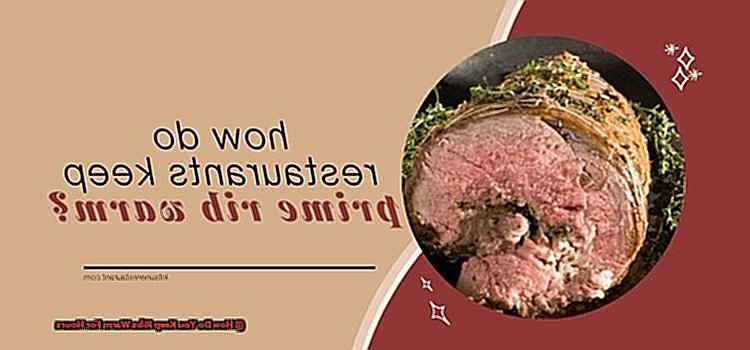
How long can I store cooked ribs?
The duration of time that cooked ribs remain edible is contingent upon their storage method. Please refer to the following table for a general guideline of how long it is safe to store cooked ribs before consuming or reheating.
| Type of Ribs | Recommended Refrigeration Timeframe | Recommended Freezing Timeframe |
| Beef Ribs | 3-4 days | 6 months |
| Pork Ribs | 3-4 days | 6 months |
| Chicken Ribs | 2-3 days | 6 months |
| Baby Back Ribs | 3-4 days | 6 months |
| Spare Ribs | 3-4 days | 6 months |
| St. Louis Style Ribs | 3-4 days | 6 months |
| Rib Tips/Pieces/Leftovers |
According to the table, cooked ribs can be safely stored for 3-4 days in the refrigerator and up to 6 months in the freezer. It is essential to note, however, that these timeframes are optimal for both quality and safety purposes; although cooked ribs may still be edible beyond these timeframes, they may not retain their flavor or texture.
When storing cooked ribs, it is crucial to place them in airtight containers or wrap them tightly to prevent exposure to air and bacteria. This will help preserve their freshness and taste.
Proper reheating techniques are also critical in avoiding the risk of food poisoning when consuming cooked ribs. They can be reheated in the oven, on the grill, or in the microwave. Please note that a minimum internal temperature of 165°F must be reached to ensure safety when reheating.
To conclude, cooked ribs can be safely stored for 3-4 days in the refrigerator and up to 6 months in the freezer. Adequate storage and reheating methods are key factors in maintaining their quality and safety.
How do I know if my stored meat is bad?
Determining if your stored meat has gone bad can be a challenging task for many people. However, with these top five signs, you can easily determine if your meat is still safe to consume.
- Check the expiration date: The first and most essential step in checking if your stored meat is still good is to check its expiration or “best by” date. This can usually be found on the packaging and serves as a reliable indicator of how long your meat will remain fresh.
- Consider the appearance: Another way to tell if your stored meat has gone bad is by examining its appearance. If it looks discolored, gray, or slimy, it is a clear indication that bacteria have started to grow on it and it should not be consumed.
- Assess the texture: The texture of your meat can also give you valuable information about its freshness. If it feels damp, moldy, or sticky, these are all signs of spoilage and the meat should not be consumed.
- Smell it: The smell of your stored meat can also be a significant indicator of spoilage. If it emits a foul or ammonia-like odor, this is a clear sign that bacteria have begun to multiply and the meat should not be consumed.
- Keep track of storage time: It’s crucial to keep track of how long your meat has been stored in the fridge. Generally, cooked meat should be refrigerated for 3-4 days before consumption, while raw meat should be eaten within 1-2 days. After these optimal time frames, the flavor and texture of the meat may diminish, making it less enjoyable to eat.
Aside from these signs, certain types of bacteria can be harmful to humans and cause food poisoning if consumed. These include E.coli, Salmonella, and Listeria. If you suspect that your stored meat may have been contaminated with any of these bacteria, it is essential to discard it immediately and not consume it.
To prevent your stored meat from going bad, make sure to keep it in airtight containers or tightly wrapped in the fridge. You can also freeze your meat for longer storage, up to 6 months, but the flavor and texture may not be as good after this time frame.
So, it is crucial to pay attention to the signs that your stored meat may have gone bad, such as appearance, texture, smell, and storage time.
How to store cooked ribs in the best ways
When it comes to preserving the warmth and flavor of your cooked ribs for an extended period, there are multiple techniques you can choose from based on your personal preferences and resources. Some of the most effective methods for storing cooked ribs include using a high-quality insulated container, wrapping them in foil and placing them in a low oven, coating them with a moistening mixture, vacuum sealing them, or utilizing food warmers or slow cookers.
The following table provides a summary of these various methods and their respective advantages:
| Method | Advantages |
|——————————————|————————————————————————————————————–|
| High-quality insulated container | Can maintain heat and moisture for several hours, making it ideal for transporting ribs |
| Foil and low oven | An inexpensive option that retains heat well, can add extra moisture by coating ribs with a mixture |
| Vacuum sealing | Can preserve freshness and flavor for longer periods of time, perfect for storing ribs in the fridge or freezer |
| Food warmers/slow cookers | Convenient for keeping ribs warm and ready to eat, can also add extra moisture |
Regardless of which method you choose, it is crucial to keep in mind a few key tips to ensure the best outcome:
- Ribs should be consumed within 16 hours of cooking for optimal freshness.
- Make sure to wrap or seal the ribs properly to retain heat and moisture.
- Avoid using open flames to check for gas leaks when using a gas grill. Instead, use a soap and water solution to wet the connections.
- If there is a gas leak, immediately shut down the grill and seek assistance from customer support.
- When using a slow cooker or food warmer, be sure to set the temperature to low or warm to prevent overcooking or drying out the ribs.
In conclusion, by following these tips and utilizing one of the recommended methods for storing cooked ribs, you can ensure that your mouth-watering BBQ remains warm and flavorful for hours.
Conclusion
In conclusion, mastering the art of keeping ribs warm for hours may seem like a daunting task, but with our expert tips and tricks, you can ensure that your ribs stay tender, juicy, and full of flavor until it’s time to serve.
From tightly wrapping them in foil to utilizing a food warmer or slow cooker, there are various effective methods at your disposal. And when it comes to reheating leftovers, remember to properly wrap the ribs and opt for a low heat setting for optimal results.
So go ahead and savor the irresistible aroma of slow-cooked ribs knowing that they will retain their warmth and deliciousness for hours on end.

